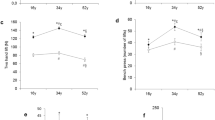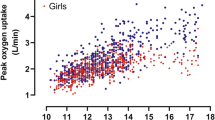Summary
The many physiological determinants of exercise performance mature throughout the childhood years. Current research suggests that the improvements in maximal aerobic power which occur as the child ages are an expression of both increased body size and improved function. Absolute V̇O2max increases during the childhood years in both girls and boys. Average V̇O2max related to bodyweight, however, remains stable in boys of all ages, while values in girls decline progressively as they grow. V̇O2 at a given treadmill speed or slope falls during the growing years. This improvement in running economy may explain parallel advances in endurance exercise performance. The explanation for greater running economy with growth is uncertain, but lower step rate, improved running mechanics, and changes in body mass: surface area ratio may play a role.
Similar content being viewed by others
References
Alpert BS, Bloom KR, Gilday D, Olley PM. The comparison between noninvasive and invasive methods of stroke volume determination in children. American Heart Journal 98: 763–766, 1979
Andersen SD, Godrey S. Cardiorespiratory response to treadmill exercise in normal children. Clinical Science 40: 433–442, 1971
Asano K, Hirakoba S. Respiratory and circulatory adaptation during prolonged exercise in 10–12 year old children and adults. In Ilmarinen & Valimaki (Eds) Children and sport, pp. 119–128, Springer Verlag, Berlin, 1984
Asmussen E. Growth in muscle strength and power. In Rarick (Ed.) Physical activity, human growth and development, pp. 60–79, Academic Press, New York, 1973
Bailey DA, Ross WD, Mirwald RL, Weese C. Size dissociation of maximal aerobic power during growth in boys. Medicine Sport 11: 140–151, 1978
Bar-Or O. Pediatric sports medicine for the practitioner, Springer Verlag, New York, 1983
Bar-Or O. The growth and development of children’s physiologic and perceptional responses to exercise. In Ilmarinen & Valimaki (Eds) Children and sport, pp. 3–17, Springer Verlag, Berlin, 1984
Bar-Or O. Trainability of the prepubescent child. Physician and Sportsmedicine 17: 65–82, 1989
Bell RD, MacDougall JD, Billeter R, Howald H. Muscle fiber types and morphometric analysis of skeletal muscle in six year old children. Medicine and Science in Sports and Exercise 12: 28–31, 1980
Berg A, Keul J. Biochemical changes during exercise in children. In Malina (Ed.). Young athletes: biological psychological, and educational perspectives, pp. 66–78, Human Kinetics Publishers, Champaign, IL, 1988
Beunen G. Biological age in pediatric exercise research. In Bar-Or (Ed.) Advances in pediatric sport sciences, Vol. 3, pp. 1–40, Human Kinetics Publishers, Champaign, IL, 1989
Cooper DM. Development of the oxygen transport system in normal children. In Bar-Or (Ed.) Advances in pediatric sport sciences, Vol. 3, pp. 67–100, Human Kinetics Publishers, Champaign, IL, 1989
Cooper DM, Kaplan MR, Baumgarten L, Weiler-Ravell D., Whipp, BJ, et al. Coupling of ventilation and CO2 production during exercise in children. Pediatric Research 21: 568–572, 1987
Davies CTM, Barnes C, Godfrey S. Body composition and maximal exercise performance in children. Human Biology 44: 195–214, 1972
Day L. The testing, prediction, and significance of maximal aerobic power in children. Australian Journal of Sport Sciences 1: 18–22, 1981
Driscoll DJ, Danielson GK, Puga FJ, Schaff HV, Heise CT, et al. Exercise tolerance and cardiorespiratory response to exercise after the Fontan operation for tricuspid atresia or functional single ventricle. Journal of the American College of Cardiology 7: 1087–1094, 1986
Eriksson BO. Physical training, oxygen supply, and muscle metabolism in 11–13 year old boys. Acta Physiologica Scandinavica (Suppl. 384): 48, 1972
Eriksson BO. Muscle metabolism in children — a review. Acta Paediatrica Scandinavica (Suppl. 283): 20–27, 1980
Eriksson BO, Gollnick PD, Saltin B. Muscle metabolism and enzyme activities after training in boys 11–13 years old. Acta Physiologica Scandinavica 87: 485–497, 1973
Godfrey S. Exercise testing in children, W.B. Saunders, London, 1974
Henry WL, Ware J, Gardin JM, Hepner SI, McKay J, et al. Echocardiographic measurements in normal subjects. Circulation 57: 278–285, 1978
Kanaley JA, Boileau RA, Massey BH, Misner JE. Muscular efficiency during treadmill walking: the effects of age and workload. Pediatric Exercise Science 1: 155–162, 1989
Katch VL. Use of the oxygen/body weight ratio in correlational analysis: spurious correlations and statistical considerations. Medicine and Science in Sports 5: 253–257, 1973
Koch G. Muscle blood flow after ischemic work and during bicycle ergometer work in boys aged 12 years. Acta Paediatrica Belgica 28 (Suppl.): 29–39, 1974
Krahenbuhl GS, Morgan DW, Pangrazi RP. Longitudinal changes in distance-running performance of young males. International Journal of Sports Medicine 10: 92–96, 1989a
Krahenbuhl GS, Pangrazi RP, Stone WJ, Morgan DW, Williams T. Fractional utilization of maximal aerobic capacity in children 6 to 8 years of age. Pediatric Exercise Science 1: 271–277, 1989b
Krahenbuhl GS, Skinner JS, Kohrt WM. Developmental aspects of maximal aerobic power. Exercise and Sport Sciences Reviews 13: 503–538, 1985
Lohman TG. Assessment of body composition in children. Pediatric Exercise Science 1: 19–30, 1989
Macek M, Vavra J, Novosadova J. Prolonged exercise in prepubertal boys. I. Cardiovascular and metabolic adjustment. European Journal of Applied Physiology 35: 291–298, 1976
Mayers N, Gutin B. Physiological characteristics of elite prepubertal cross-country runners. Medicine and Science in Sports 11: 172–176, 1979
Middeke M, Remien J, Holzgrere H. The influence of sex, age, blood pressure, and physical stress on beta-2 adrenoreceptor density of mononuclear cells. Journal of Hypertension 2: 261–264, 1984
Mirwald RL, Bailey DA. Maximal aerobic power: a longitudinal analysis, Sports Dynamics, London, Ontario, 1986
Mirwald RL, Bailey DA, Cameron N, Rasmussen RL. Longitudinal comparison of aerobic power in active and inactive boys aged 7.0 to 17.0 years. Annals of Human Biology 8: 405–414, 1981
Oseid S, Hermansen L. Hormonal and metabolic changes during and after prolonged muscle work in prepubertal boys. Acta Paediatrica Scandinavica (Suppl. 217): 147–153, 1971
Puhl JL. Energy expenditure among children: implications for childhood obesity. I. Resting and dietary energy expenditure. Pediatric Exercise Science 1: 212–229, 1989
Robinson S. Experimental studies of physical fitness in relation to age. Arbeitsphysiologie 10: 18–23, 1938
Ross Laboratories. Children are different: relation of age to physiologic function, Columbus, Ohio, 1970
Rowland TW. Ethical considerations in pediatric research: how much is too much? Pediatric Exercise Science 1: 93–95, 1989a
Rowland TW. Oxygen uptake and endurance fitness in children: a developmental perspective. Pediatric Exercise Science 1:313–328, 1989b
Rowland TW. Exercise and children’s health, pp. 57–63, Human Kinetics, Champaign, IL, 1990
Rowland TW, Auchinachie JA, Keenan TJ, Green GM. Physiologic responses to treadmill running in adult and prepubertal males. International Journal of Sports Medicine 8: 292–297, 1987
Rowland TW, Green GM. Physiologic responses to treadmill running in females: adult-child differences. Medicine and Science in Sports and Exercise 20: 474–478, 1988
Rowland TW, Staab J, Unnithan V, Siconolfi S. Maximal cardiac responses in prepubertal and adult males. Abstract. Medicine and Science in Sports and Exercise 20 (Suppl.): S32, 1988
Rowland TW, von Duvillard S. Exercise cardiac contractility in men and boys: a recovery echocardiographic study. International Journal of Sports Medicine, in press, 1990
Rutenfranz J, Andersen KL, Seliger V, Klimmer F, Berndt S, et al. Maximal aerobic power and body composition during the pubertal growth period: similarities and differences between children of two European countries. European Journal of Pediatrics 136: 123–133, 1981
Scammon RE. A summary of the anatomy of the infant and child. In Abt (Ed.) Pediatrics, pp. 257–444, W.B. Saunders, Philadelphia, 1923
Schaible TF, Malhotra A, Ciambrone G, Scheuer J. The effects of gonadectomy on left ventricular function and cardiac contractile proteins in male and female rats. Circulation Research 54: 38–49, 1984
Schmidt-Nielsen K. Scaling: why is animal size so important? Cambridge University Press, Cambridge, 1984
Shephard RJ. Physical activity and growth, pp. 80–85, Year Book Medical Publishers, Chicago, 1982
Shephard RJ, Lavallee H, LaBarre R. On the basis of data standardization in pre-pubescent children. In Ostyn (Ed.) Kinanthropometry II, Karger, Basel, 1980
Author information
Authors and Affiliations
Rights and permissions
About this article
Cite this article
Rowland, T.W. Developmental Aspects of Physiological Function Relating to Aerobic Exercise in Children. Sports Med 10, 255–266 (1990). https://doi.org/10.2165/00007256-199010040-00004
Published:
Issue Date:
DOI: https://doi.org/10.2165/00007256-199010040-00004




